Must-see In Champasak - Explore Wat Phou - The Oldest Temple In Champasak

Laos, the Land of a Thousand Elephants, captivates travelers with its unique culture. What to do in Champasak ? Wat Phou, an over 1,000-year-old temple in Champasak province, attracts many tourists with its ancient architecture and historical tales. Explore Wat Phou Champasak, a must-visit in Laos, with AUTOUR ASIA, your local travel agency in Laos.
Wat Phou, a must-see in Champasak
- I. History of Wat Phou, the oldest temple in Champasak
- II. Everything you need to know about Vat Phou, the oldest temple in Champassak Laos
- III. Why is Vat Phou so fascinating? Top things to do when visiting Vat Phou, a must-visit in Laos
- IV. Best time to visit Wat Phou in Champassak, Laos
- V. Everything you need to know before visiting Wat Phou
I. History of Wat Phou, the oldest temple in Champasak
Wat Phou, also known as Vat Phou, is the oldest temple in Champassak Laos, with a history even older than the Angkor sites in Cambodia. This Champasak temple is considered a national pride for the Lao people and a must-visit in Laos.
According to researchers, Wat Phou was originally a center dedicated to Hinduism, worshipping the god Shiva. While the Angkor civilization is closely associated with Angkor Thom and Angkor Wat (7th-8th centuries), few know that Wat Phou Laos, a Hindu worship center, was built as early as the 5th century. The remaining structures date back to the 11th-13th centuries.
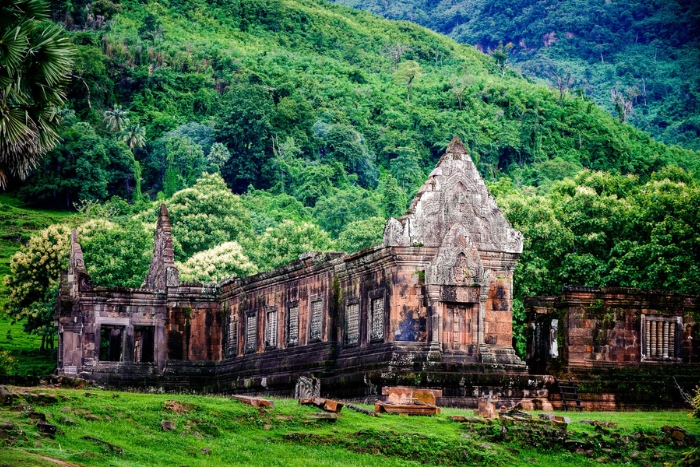
What to do in Champasak? Wat Phou Champasak was considered the most sacred temple of the Khmer Empire before attention shifted southward to build Angkor Wat in Cambodia. However, in the 13th century, the Khmers transformed this site into a Buddhist monastery, making it a center of Theravāda Buddhism—a role it still holds today while preserving significant historical and cultural values for Laos.
Listed as a UNESCO World Heritage Site since 2001, this Champasak temple, located west of the Mekong and south of Pakse, is a true historical treasure. Don't miss a visit to Vat Phou, one of the best places to visit in Laos, to explore a place rich in history and culture.
II. Everything you need to know about Vat Phou, the oldest temple in Champassak Laos
Wat Phou Champasak, a UNESCO World Heritage- listed Champasak temple, is an ancient Khmer civilization site located in southern Laos, at the foot of the sacred Phou Kao Mountain (Mount of Elephants) in Champasak province, just 6 km from the Mekong River. It is surrounded by the 4,000 Islands of the Mekong, known as Siphandone. The site holds numerous remnants of ancient civilizations, including sandstone palaces and Theravāda Buddhist temples.
What to do in Champasak? Wat Phou Laos is one of the oldest Hindu temples in Southeast Asia, boasting impressive architecture and a rich Khmer spiritual heritage. This Champasak temple is famous for its mysterious carvings, including stone-engraved crocodiles, lingams atop the mountain, and serpent-shaped stairways.
Wat Phou Champasak, also known as the "Mountain Temple," is located at the foot of Mount Voi, at an altitude of 1,600 meters. It sits on Linga Hill, a symbol of the god Shiva, representing fertility and the continuity of life.
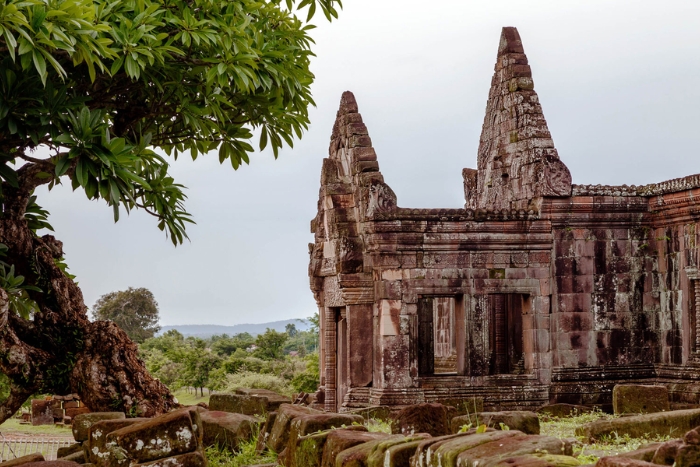
The complex dates back to the 5th century, but the remaining structures are from the 11th to 13th centuries. Vat Phou features unique architecture, with a sanctuary dedicated to the Linga, nourished by waters flowing from the sacred mountain. At the temple entrance, a museum displays over 100 statues, bas-reliefs, and stone carvings dating from the 5th to 11th centuries. The temple’s gateway and facade are adorned with bas-reliefs depicting Hindu gods.
As visitors enter Vat Phou Laos, they follow a paved path leading to the foot of the mountain, lined with Linga-shaped columns, symbolizing Shiva. This path leads to two main temples, facing east and perched on a promontory. All structures on the site are made of stone.
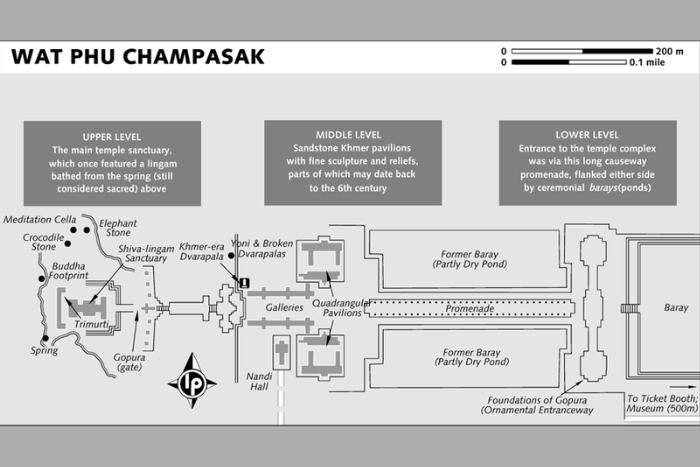
What to do in Champasak? At Vat Phou, one of the must-visits in Laos, the upper temple, located midway up the mountain, is accessible via stone steps flanked by cylindrical columns. Built from large, intricately carved stone blocks, the temple showcases the craftsmanship of ancient artisans. Behind it, a rock wall features bas-relief statues, skillfully sculpted centuries ago. The construction of this Champasak temple, involving the transport and carving of massive stones to create a solid yet harmonious structure on the mountain, is a testament to the ingenuity and dedication of its builders.
Wat Phou remains a major religious and cultural center, hosting traditional festivals, including the annual Wat Phou Festival, where pilgrims gather to pay homage to the temple. Despite the ravages of time and war, this Champasak temple continues to stand as a guardian of Laos' rich history and cultural heritage.
III. Why is Vat Phou so fascinating? Top things to do when visiting Vat Phou, a must-visit in Laos
Vat Phou is an ancient site and a significant cultural and religious symbol of Laos. As one of the oldest Hindu temples in Southeast Asia, it showcases traditional Khmer architecture and beliefs. Despite centuries of existence, it still bears traces of the Khmer civilization and has become an important religious and cultural center.
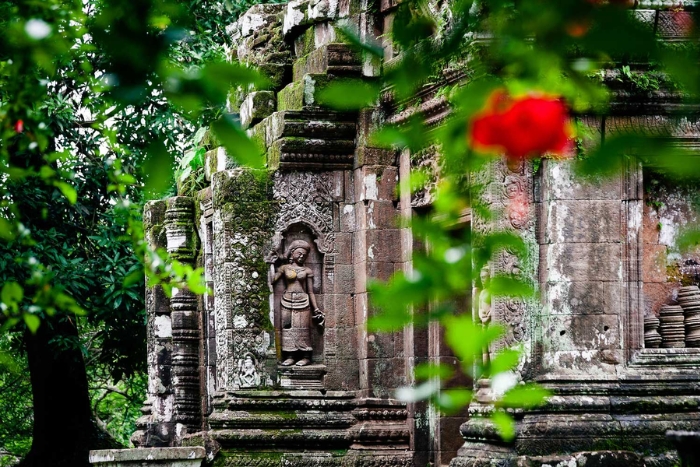
Located at the foot of the sacred Phou Kao Mountain, on the banks of the Mekong River, the Vat Phou temple complex harmoniously blends nature and spirituality, creating a mystical and captivating atmosphere. The site stands out with its intricate bas-reliefs, ancient paved walkways, and unique sandstone structures.
More than just a historical monument, Vat Phou Laos is a pilgrimage site and a cultural hub that offers unforgettable experiences for visitors. Additionally, a visit to this Champasak temple allows travelers to admire the breathtaking landscapes surrounding the temple.
If you're wondering, "What to do in Champasak?", check out our list of things to do when visiting Wat Phou, a must-visit in Laos:
1. Explore the ancient architecture
Wat Phou, an ancient architectural masterpiece, reflects the influence of Khmer culture and Hinduism. This Champasak temple impresses visitors with its finely carved stones and harmonious layout, showcasing the skill of past artisans. To reach Wat Phou, visitors pass through a historical museum preserving cultural treasures. The museum houses over 100 stone sculptures and bas-reliefs with Indian influences, dating from the 5th to 11th centuries.
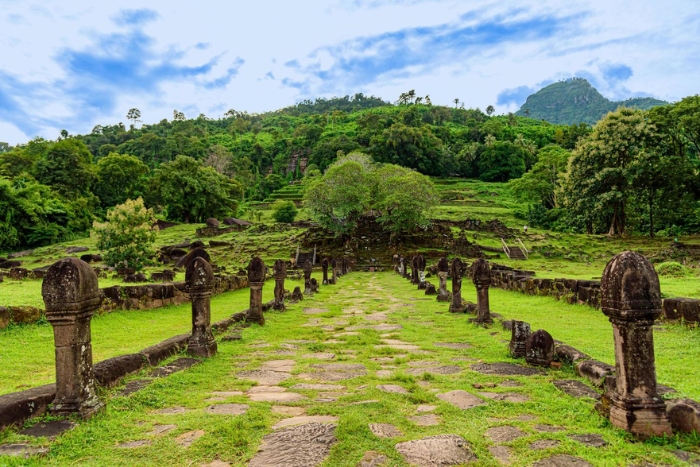
Wat Phou Laos, although its main gateway is damaged, it still retains remarkable artistic finesse. From there, a paved pathway leads directly to the two main temples, perched on a hill and facing east. Lined with Linga-shaped columns, symbolizing Shiva, this pathway gives the site a majestic atmosphere. The main sanctuary of Vat Phou, built with a special type of stone and carefully restored to preserve its authenticity, is dedicated to Shiva. Its intricate carvings and Hindu motifs make it a must-visit site in Champasak, Laos.
To reach the upper temple, visitors must climb several stone steps, flanked by slender columns. Outside, imposing stone statues symbolize divine power. The entire Vat Phou Laos complex showcases the craftsmanship of ancient artisans, who meticulously assembled these massive stone blocks to create an architectural gem perched on the mountain.
2. What to do in Champasak? Admire the ancient bas-reliefs and statues
At the foot of the mountain, the Wat Phou Museum houses around 100 artworks, mainly sandstone statues collected from the site. Among the most impressive pieces are numerous Lingas of various sizes, along with a rare Linga and Yoni set in sandstone, symbolizing the vital force of Shiva.
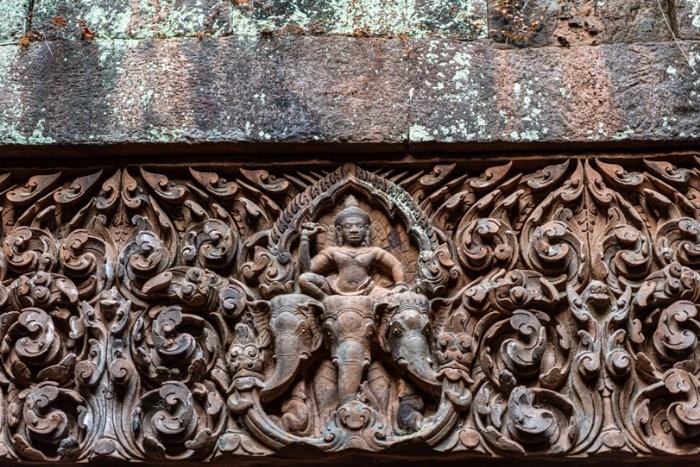
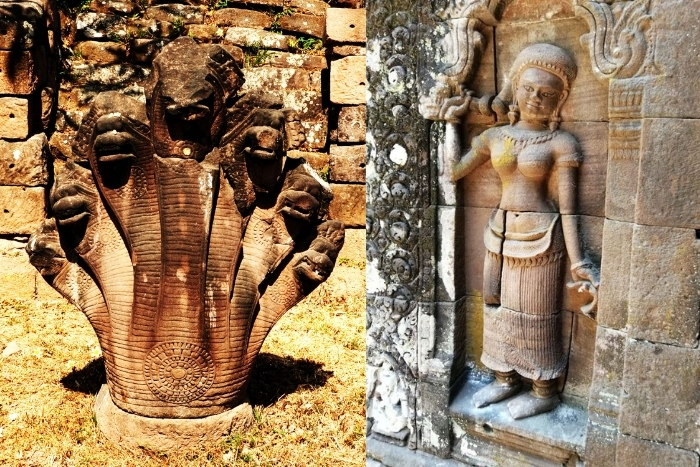
The museum also displays altars, statues of Hindu deities such as Shiva, Vishnu, Garuda, and the lion, as well as numerous Buddhist statues. This makes Wat Phou one of the best places to visit in Laos for history and spirituality enthusiasts.
3. Experience a spiritual journey at Wat Phou
Wat Phou, also known as Vat Phou Laos, remains a pilgrimage site for Buddhists. Around the temple, you'll find flowers and offerings, a typical sight in Laos. Visitors can buy beautifully arranged flowers and place them on Buddha statues, offering prayers and paying respects.
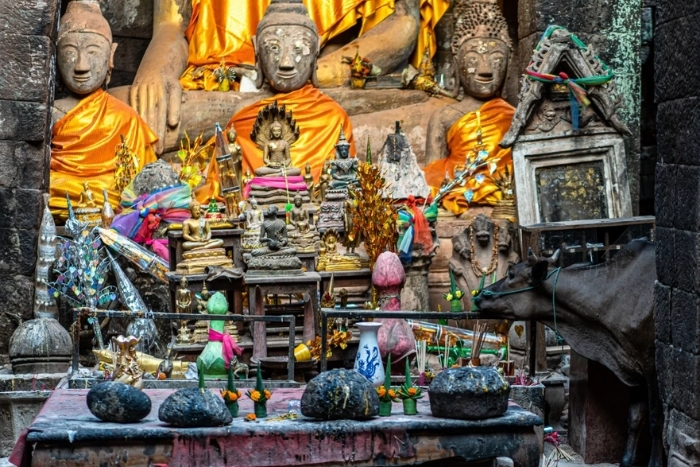
4. Discover the Wat Phou temple festival
If you visit Wat Phou in Champassak Laos during the full moon of the first lunar month, you’ll get to experience the lively annual Wat Phou Festival. This event is the largest Buddhist festival in southern Laos and one of the most significant celebrations for the Lao people.
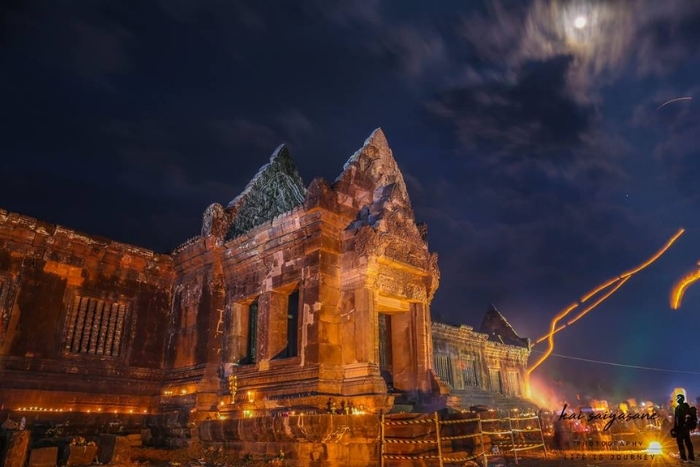
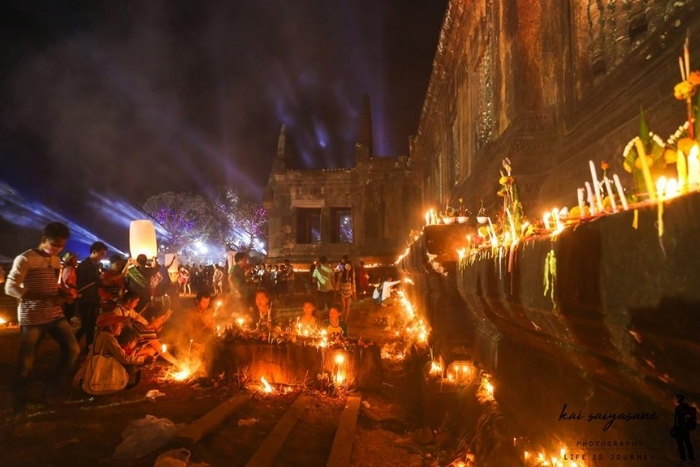
For three days, visitors can enjoy boat races, bullfighting, traditional dances, and fireworks. During this time, solemn Buddhist ceremonies are also held, adding to the spiritual significance of the festival.
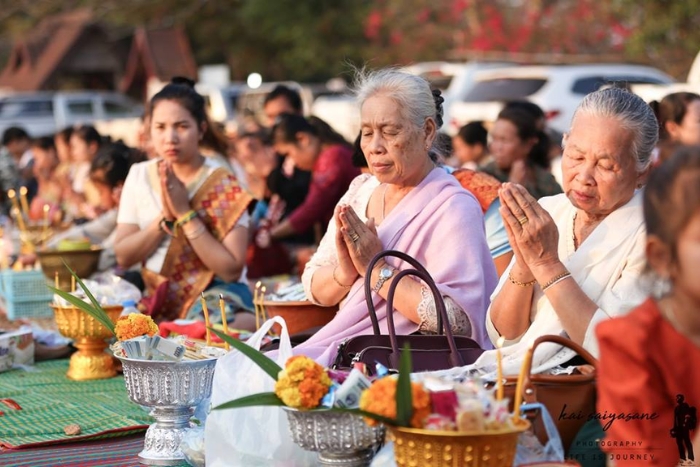
5. Admire stunning natural landscapes
Vat Phou is set in a breathtaking location, nestled against the sacred Phou Kao Mountain (Mount of Elephants) and overlooking the Mekong River. Visitors can enjoy a panoramic view of the legendary river in front and the majestic sacred mountain behind. The perfect harmony between nature and ancient architecture, preserved through the centuries, creates a mystical and captivating landscape, making Wat Phou, a must-visit in Laos.
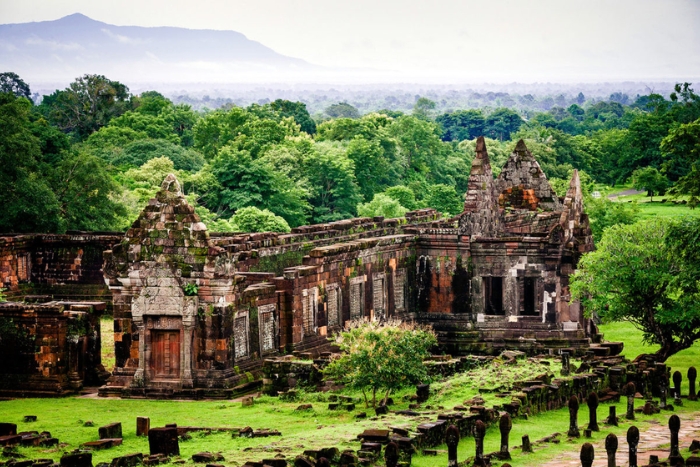
You Might Be Interested In:
> Review of the Laos Cambodia 15-day tour
> Review of a Laos family trip 2 week
IV. Best time to visit Wat Phou in Champassak, Laos
When traveling to Champassak, Laos, the ideal time to visit Wat Phou is during the dry season, from November to March. During this period, the weather is cool, less humid, and not too hot, making it easier to explore the ancient temple and its surroundings. This is also when the Mekong River is at its lowest level, offering clearer views of Vat Phou and its majestic natural landscapes. However, it's recommended to bring a light jacket, as early mornings and evenings can be chilly.
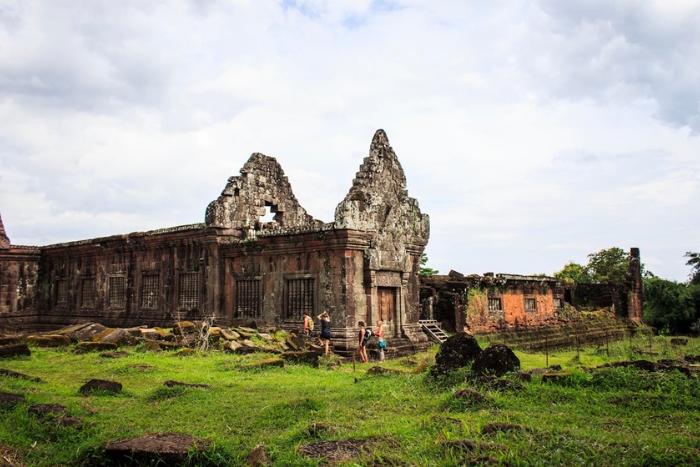
While Vat Phou Laos can be visited year-round, the rainy season from May to October can make the visit more challenging due to high humidity and heavy rainfall. The paths within the site may become slippery and muddy, making movement difficult. Additionally, the rising Mekong River can obstruct visibility, affecting the overall experience. For an optimal visit, the dry season from November to March remains the best time to explore Vat Phou, one of the best places to visit in Laos.
V. Everything you need to know before visiting Wat Phou
1. Rules to follow when visiting temples, including Wat Phou
When visiting Wat Phou, it is important to respect local customs and show reverence for this religious site. This Champasak temple, with its Khmer ruins and ancient sculptures, is a Buddhist pilgrimage site. Therefore, dress modestly by covering your shoulders and knees, and remove your shoes before entering the temples. Maintain silence and avoid touching sacred objects.
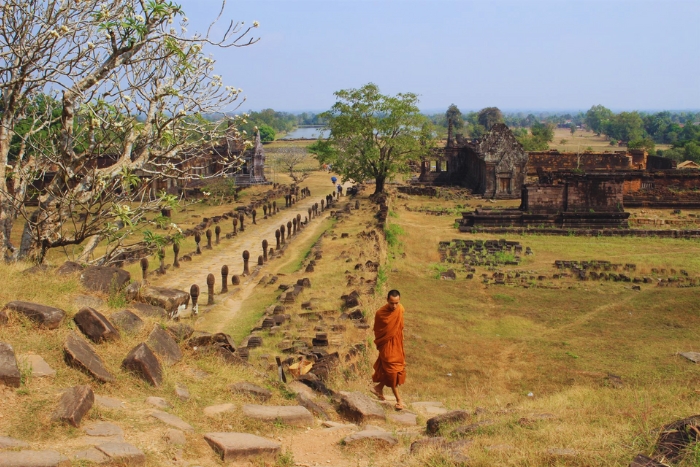
In the pagodas of Vat Phou, walk around the Buddha to the left and avoid pointing your feet toward him. Do not touch the Buddha, sit with your back to him, or direct your feet in his direction. Respect the sacred space by keeping your head lower than the statues and avoiding any disruptive behavior. Do not sit or stand higher than the monks, and do not disturb their daily routines. If you are a woman, be aware that touching them is strictly forbidden.
When exploring Vat Phou Laos, always ask for permission before taking photos of local residents. During ceremonies, maintain a respectful attitude, avoid physical contact with monks, and do not hand them offerings directly. You may make an offering if you wish, but be sure to respect local traditions.
2. Practical tips for exploring Wat Phou - a must-visit in Laos
For your visit to Wat Phou, wear comfortable clothing suited for the climb to the main temple, and make sure to bring sturdy hiking shoes. Don't forget essentials like water, a hat for sun protection, and sunscreen.
If you're there during the annual Wat Phou Festival, held for three days during the full moon of the Lao Buddhist month of March, you'll witness a unique cultural experience. This event combines religious ceremonies with traditional festivities, allowing you to immerse yourself in local customs while appreciating the site's spiritual significance.
What to do in Champasak? Wat Phou is one of the best places to visit in Laos, offering a unique experience blending history, culture, and spirituality. With its Khmer architecture and UNESCO World Heritage status, this Champasak temple stands as a testament to Laos' rich historical significance. By respecting local customs, you’ll enjoy a meaningful visit that combines exploring the past with discovering living traditions. To plan your trip, contact us at AUTOUR ASIA and explore our tailor-made tours in Laos.
You can refer to:
Click on our article about transportation in Champasak for more details. How to get around Champasak Laos? You can fly to Pakse International Airport, located about 30 km from the site. From there, you can reach Wat Phou by taxi or tuk-tuk, with a journey of around 45 minutes. If traveling by bus, you can reach Pakse from Vientiane, Luang Prabang, or Savannakhet. Once in Pakse, a local bus or minivan will take you to Wat Phou in 30 to 45 minutes, costing between $5 and $10. For more flexibility, you can rent a tuk-tuk from Pakse or nearby areas. This Champasak transportation option allows a flexible visit to Vat Phou and its surroundings, with fares to be negotiated.
For more information on must-visits in Laos, check out our guide on things to do and see in Champasak! Wat Phou is the region’s most iconic site. Don’t miss the 4,000 Islands (Si Phan Don), the spectacular Khone Phapheng and Tat Somphamit waterfalls, as well as traditional villages and peaceful rice fields. Also, explore Don Daeng Island and the stunning Bolaven Plateau for a truly immersive experience.
The ideal duration for exploring Laos, including Wat Phou and its surroundings, depends on your pace and expectations. We offer customized tours ranging from 9 days for a trip to 10 days or 21 days for a deeper immersion, including Wat Phou and Si Phan Don (the 4,000 Islands). Contact us at AUTOUR ASIA, your local travel agency in Laos, to plan a trip tailored to your desires!
Related travel guide
Other similar articles
CUSTOMIZABLE BY LOCAL EXPERTS
Personalized trip at the original price!
REFUND GUARANTEE
We believe in our work and promise to give you money back.
GOOD PRICE / QUALITY
95% satisfied more than expected!
24/7 LOCAL SUPPORT
We are always available online to provide assistance at any time.
Most read articles
Autour Asia is highly recommended on
Embracing the mission of "Satisfied more than expected" and providing authentic experiences, we have received numerous recommendations on reputable travel forums:























